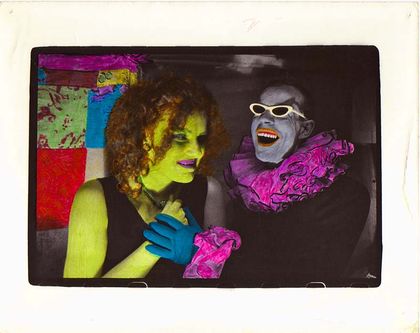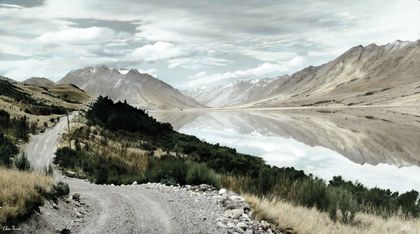Speaker: Colouring Girl
31 Responses
First ←Older Page 1 2 Newer→ Last
-
-
My mother used to hand colour black and white photos. I remember seeing a half finished one as a kid, and marvelling at how realistic the colours looked.
It's amazing that Nola Mann worked through to 1998. I'd've expected that the job would've demised pretty rapidly around the mid 70's when colour photography became mainstream.
-
Wonderful story! Can you give us a link to the Loading Docs film festival?
-
Great story, thanks. I was taught (a little) to touch up black and white photos using a fine paintbrush and shades of grey, black and white. Back in the 70s my parents bought a package - b/w aerial photo of the farm which was then hand-coloured and framed. Unfortunately, the colourist read the instructions written on the b/w proof incorrectly and a tree ended up covered in pink flowers. (The line to where the pink should have gone continued on through the tree.) Never mind, it's still a great photo and still hangs in the farm house.
-
Marvelous piece of history, thanks so much for this.
A photo about 35x50cm would take about one morning to colour.
That's pretty quick, even by digital standards.
Some may find the Colourising New Zealand Facebook page of interest. For me the examples that don't come off are when someone has pitched in with the digital colouring without tweaking the tones of the black and white original for maximum clarity, and the results can be disappointingly flat or lost in shadow. No doubt Whites Aviation had that down to a fine art.
A modern-day "colorizer" whose work I enjoy is Patty Allison, who blogs under the moniker Imbued with Hues. Although she's based in Portland, Maine, one of her nicer works is a treatment of a 1930s shot of Titahi Bay. While she claims to rigorously research her historical subjects, the golden tone if those sands seems inspired by somewhere other than Porirua.
-
Congratulations to everyone involved. Astoundingly good research, succinct and inspiring - romantic too! Successfully revealing important New Zealand history, local perspectives and the history of women in our workforce as cultural creators, A fantastic insight into our past lives - love it! Hand colouring lived large on the walls at our home in Brooklands, New Plymouth and inspired me to later pursue my own hand coloured images. I remain in pursuit of the hand coloured world.
-

Great story, thanks, nice one Greg Wood et al. An interesting history and wonderful to think that people were hired full-time to paint on photographs. My Dad Webster used to hand colour photographs in this way, I remember seeing that exact box of oil paints in the trunk in the garage. Personally I never did any with oils, but discovered water based felt pens that did a great job (although more psychedelic than natural) and later on I screen-printed colour versions of black & white photos.
-
Very interesting. Thanks. Presumably it should be Bruegel or Brueghel instead of Brugal for the prints that were around earlier. Pieter Bruegel the Elder or Jan Brueghel the Elder or Pieter Brueghel the Younger.
-
My parents still have a Whites aerial photo of Ninety Mile Beach on their wall, bought when we were living in Kaitaia - so about 45 years ago. I always thought it was a colour photo, but by the sound of this It may be a colourised photo - I'm going to have to have a closer look next time I visit. It definitely had
the flowing ‘Whites’ signature.
-
Sacha, in reply to
a link to the Loading Docs film festival
-
Russell Brown, in reply to
and the history of women in our workforce as cultural creators
That's what really stands out for me.
-
Enjoyable piece on cultural history, thank you.
Interestingly enough, my own favourite piece of original art is a photographic landscape of trees in Taranaki, overpainted in an atmospheric style. Can't recall the artist right now, unfortunately. Piece is from the early 2000s.
In any case, some of us kiwis still rate hand-coloured landscape art on our walls!
-
Ian Dalziel, in reply to
Also don’t miss Same but Different by Director/Producer Louise Leitch
Read more about it here:
http://www.stuff.co.nz/entertainment/film/82766773/loading-docs-short-film-depicts-friendship-that-transcends-gender-transition -
Hey, here's a thing ...
I've just learned that Whites Aviation was the company of Leo White – whose grandson is ace news and feature photographer David White.
David's dad Ross White was a photographer too.
-
This is a lovely description of what looks like a lovely documentary.
Just one thing. When you write "a large Lake Taupo photograph worked on by four girls in 1963" it jars. I can cope with 'girls' in inverted commas, or maybe even "four of the girls", since they apparently called themselves the 'colouring girls'. But in that sentence, with that photograph... well, they look like women to me.
-
Peter Alsop, in reply to
Thx all for comments and enjoying the Whites' legacy - am enjoying the various stories and threads. The end date for Nola Mann is a little fuzzy but best I could determine from discussion with owners of Air Logistics. Hopefully we’ll hear from Nola’s kids if they hear of the doco. Peter
-
I’ve just learned that Whites Aviation was the company of Leo White – whose grandson is ace news and feature photographer David White.
That’s right Russell. I interviewed Ross and he has been a great supporter of the book and very encouraging to me personally. I’d like to meet David at some point; he took a great photo of my day job CEO recently! Leo White was quite a man ... perhaps a blog on him alone in a few weeks!!!! I’m gunning for Leo to enter the NZ Business Hall of Fame, he deserves to be there.
When you write “a large Lake Taupo photograph worked on by four girls in 1963” it jars
Lucy, thx for constructively raising this concern (without an anti-Kevin-Roberts bite!) – I can understand your view. I thought with the scene-setting around ‘girls’, the context for the piece was clear but, given your fair feedback, I hope Russell will be so kind as to add some quote marks throughout. Thx Lucy.
-
Wow, what a fascinating story! And doesn't Grace Rawson still have a steady hand and a sure touch!
A curious fact that colour photographic prints have never had the archival qualities of black-and-white, which if treated well can last 100-200 years. Colour photographs are still very prone to colour shifts and fading over time. I imagine White's black-and-white prints coloured with oil paint would retain their colour well.
I suspect it's only with the development of archival pigment-based inks for inkjet printers that hand-colouring has been outmoded.
And what a beautiful process! I did a little retouching when I was at design school and it's so hard to make the colour even. Maximum respect to these ladies!
-
Russell Brown, in reply to
Lucy, thx for constructively raising this concern (without an anti-Kevin-Roberts bite!) – I can understand your view. I thought with the scene-setting around ‘girls’, the context for the piece was clear but, given your fair feedback, I hope Russell will be so kind as to add some quote marks throughout. Thx Lucy.
Will do. I wondered about the headline at first glance too, and then realised the context when I read the text.
-
Peter Alsop, in reply to
In the sensitive-age-of-now, just confirming that in Grace's eyes and own words, she worked with the girls. Colouring Girl was the original title for a chapter in the book (about Grace, with title sanctioned by her). The title in the book changed for another reason to 'One of the Girls', which has a double meaning in terms of Clyde Stewart, Mr-Hand-Colouring-New-Zealand, being referred to in one of my interviews as 'one of the girls'. Stewart ran the studio and employed and mentored the 'girls' ... and they loved him. He ran colouring at Whites for 37 years and was also chief photographer. Without diminishing Leo's amazing leadership, Stewart is Whites' unsung hero.
-
Some may find the Colourising New Zealand Facebook page of interest.
Brendan Graham, Colourising New Zealand, digitally coloured a photo specially for the book - and did an incredible job. I felt the book had to dip into digital colouring to recognise the relevance and influence of hand colouring in contemporary culture.
-
Russell Brown, in reply to
The title in the book changed for another reason to ‘One of the Girls’, which has a double meaning in terms of Clyde Stewart, Mr-Hand-Colouring-New-Zealand, being referred to in one of my interviews as ‘one of the girls’.
Which is really interesting. It implicitly acknowledges that this was a women's craft, women were the experts. And yet this all fell out of history, while the narratives of the New Zealand canon were established in lore.
That same might be said of the commercial art books you've published, Peter. It's the reason I'll always want to support what you do.
-
Sacha, in reply to
archival pigment-based inks for inkjet printers
ooh, link please
-
Lilith __, in reply to
archival pigment-based inks for inkjet printers
ooh, link please
It’s costly and I’ve only seen it advertised in commercial settings, such as my old friends at Microfilm Digital Print in Chch. Archival prints also require acid-free printing paper.
Home-grade inkjet prints will fade after a few months on the wall. Interestingly, cheap colour-laser prints (or laser photocopies) retain their colour much longer because the toner is made of particles rather than a thin film of transparent ink.
-
What a great read... thankyou for the insight...
Slightly related... one of the heirlooms I look forward to inheriting in due course is a hand coloured photograph of my deceased grandmother, taken when she was ~16ish... I'm guessing from my (imprecise) knowledge of her age when she passed away, and the fashion on show, it was probably 1920-1935?. It looks just like my mother... Apparently Nan was never impressed with the picture because as pretty and stylish as it is... the dress is painted a soft peach colour... when in fact it was a sky/baby blue :)


Post your response…
This topic is closed.